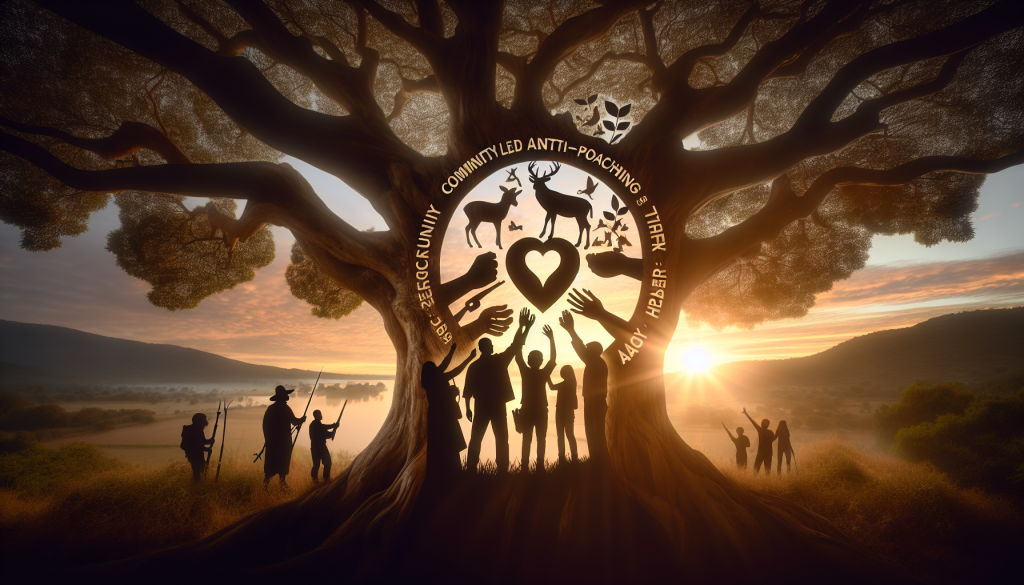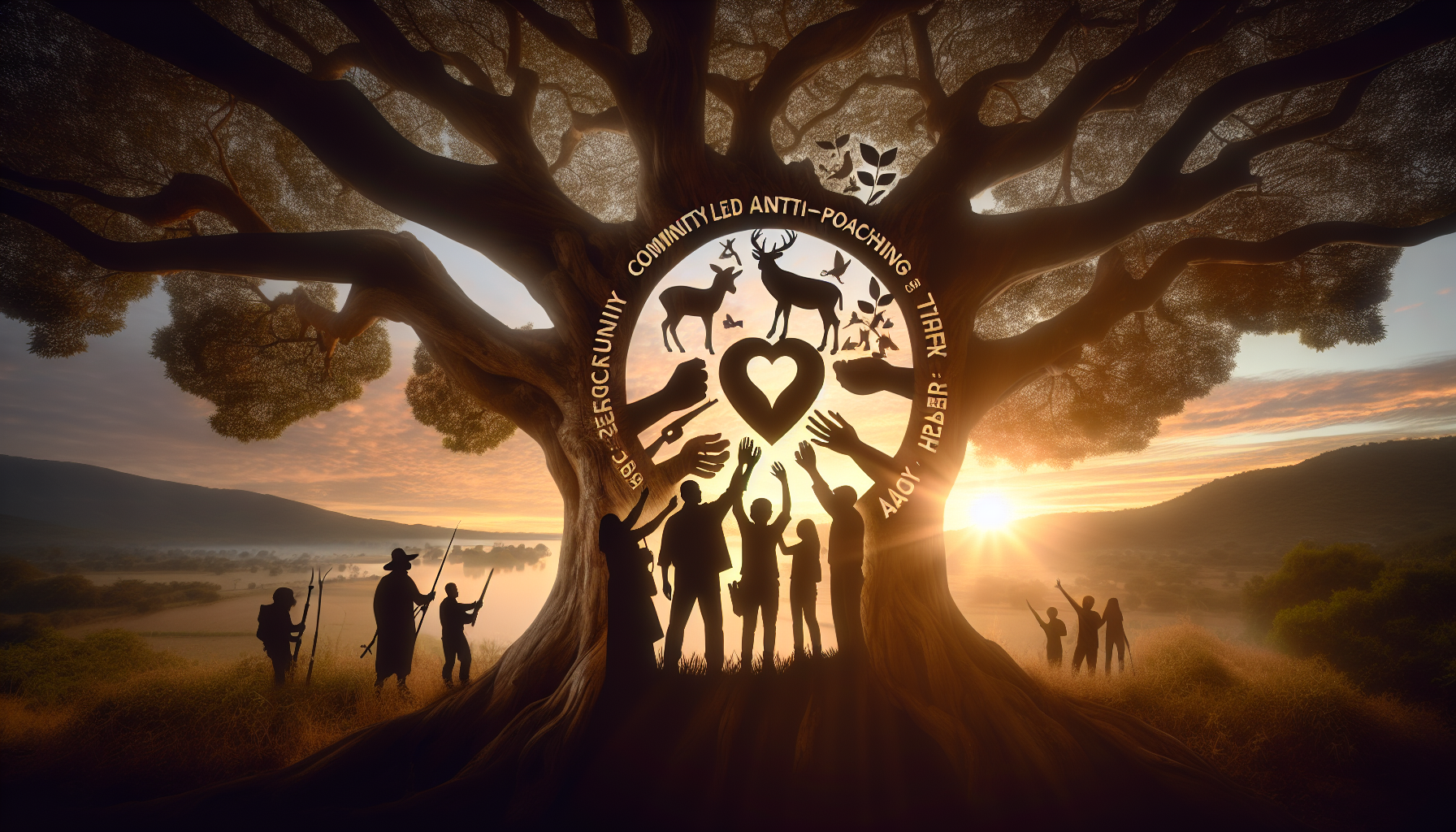Imagine a world where endangered species thrive and poaching is a thing of the past. Sounds like a utopia, right? Well, it turns out that the key to achieving this lies in the hands of the very people who live alongside these threatened animals – the local communities. In recent years, there has been an increasing recognition of the vital role that these communities play in anti-poaching efforts. From their deep knowledge of the area to their vested interest in protecting their natural resources, local communities are proving to be powerful allies in the fight against this illicit trade. This article will explore the various ways in which local communities are stepping up and making a significant impact in the battle against poaching.

Understanding the Importance of Local Communities in Anti-Poaching Efforts
Effective anti-poaching efforts require the active participation and engagement of local communities. These communities play a crucial role in combating poaching and preserving wildlife because of their unique knowledge, connection to the land, and vested interest in conservation. By understanding the contributing factors, integrating indigenous knowledge, and building trust and cooperation, we can empower local communities to become key stakeholders in anti-poaching efforts.
Contributing Factors
Several factors contribute to the importance of local communities in anti-poaching efforts. Firstly, local communities often have intimate knowledge of the natural environment and the behavior of local wildlife, making them valuable sources of information for identifying poaching activities. Additionally, community members are typically the first to notice any suspicious activities or the presence of poachers in their areas, serving as an early warning system.
Moreover, local communities are directly affected by the impact of poaching on their livelihoods and cultural heritage. Poaching not only threatens the wildlife populations but also disrupts the delicate balance of ecosystems, which can have detrimental effects on communities that depend on these resources for their sustenance, income, and cultural practices.
Integrating Indigenous Knowledge
Indigenous knowledge, passed down through generations, holds invaluable wisdom about the natural world and the behavior of wildlife. Integrating this knowledge into anti-poaching efforts can significantly enhance their effectiveness. Local communities possess unique insights into wildlife movements, patterns of behavior, and ecological interdependencies, thereby enabling more targeted and informed conservation strategies.
Through collaborations between conservation organizations and indigenous communities, a deeper understanding of the local environment can be gained. Indigenous knowledge can complement scientific research, providing a holistic approach to wildlife conservation by incorporating traditional practices and wisdom into modern anti-poaching strategies.
Building Trust and Cooperation
Developing trust and cooperation between local communities and conservation stakeholders is crucial for successful anti-poaching efforts. The establishment of positive and respectful relationships is essential to encourage community involvement and ensure their active participation in conservation initiatives.
Engaging local communities in dialogue and decision-making processes empowers them, giving them a sense of ownership and responsibility for the protection of wildlife. By actively involving communities in the planning and implementation of anti-poaching measures, they become invested in the success of these efforts and are more likely to take an active role in deterring poachers.
Empowering Local Communities in Anti-Poaching Efforts
To effectively empower local communities to participate in anti-poaching efforts, various strategies can be implemented. These include education and awareness programs, alternative livelihood initiatives, and capacity building programs.
Education and Awareness
Providing education and raising awareness about the importance of wildlife conservation can help instill a sense of responsibility and pride among community members. Educating local communities about the ecological significance of wildlife and the negative impacts of poaching can foster a culture of conservation.
This can be achieved through informational campaigns, workshops, and educational programs tailored to the specific needs and cultural context of the community. By fostering a deeper understanding of the value of wildlife and the benefits of conservation, community members are more likely to actively support and participate in anti-poaching efforts.
Alternative Livelihoods
One of the primary motivations for engaging in poaching activities is often economic necessity. Creating alternative livelihood opportunities can alleviate the pressures on communities to resort to poaching as a means of survival or income generation.
Identifying sustainable income-generating activities that are compatible with conservation goals, such as ecotourism, handicrafts, or sustainable agriculture, can offer viable alternatives to poaching. Supporting the development of these alternative livelihoods through training, access to markets, and financial incentives can significantly reduce the dependence on poaching, while simultaneously improving socio-economic conditions.
Capacity Building
Capacity building programs aim to enhance the skills and knowledge of local communities to effectively participate in anti-poaching efforts. These programs can include training in wildlife monitoring techniques, community-based surveillance systems, conflict resolution, and law enforcement.
By equipping community members with the necessary skills and knowledge, they can actively contribute to anti-poaching efforts. Capacity building programs also empower communities to effectively collaborate with law enforcement agencies and conservation organizations, enabling them to become equal and competent partners in combating poaching.
Collaboration and Partnerships with Local Communities
Collaboration and partnerships between local communities, governmental initiatives, non-governmental organizations (NGOs), and private sector entities are essential for the success of anti-poaching efforts. These partnerships leverage the diverse strengths, resources, and expertise of each stakeholder, ultimately leading to more effective and sustainable conservation strategies.
Government Initiatives
Government initiatives play a crucial role in facilitating collaboration with local communities. Creating an enabling policy and legal framework that promotes community participation in conservation is essential. Governments can provide financial support, establish community-led conservation areas, and develop regulations that prioritize the rights and responsibilities of local communities.
Additionally, governments need to actively involve local communities in decision-making processes related to land and resource management. By including community voices in policy discussions and incorporating their traditional knowledge, governments can create a more inclusive and effective approach to anti-poaching efforts.
Non-Governmental Organizations
NGOs play a critical role in supporting and empowering local communities in anti-poaching efforts. They often have extensive experience in community engagement, conservation planning, and resource mobilization. NGOs can provide technical expertise, funding opportunities, and capacity building programs to enable local communities to actively participate in conservation initiatives.
By fostering partnerships with community-based organizations, NGOs can facilitate the exchange of knowledge, resources, and support channels. These collaborations strengthen the collective efforts to combat poaching, ensuring a more holistic and sustainable approach to conservation.
Private Sector Engagement
Private sector engagement is another important aspect of collaboration in anti-poaching efforts. By aligning conservation goals with corporate social responsibility initiatives, companies can contribute to wildlife protection while simultaneously fulfilling their business objectives.
Private sector entities can provide funding, resources, and expertise to support community-based conservation efforts. Through partnerships with local communities, businesses can enhance their reputations, promote sustainable practices, and contribute to the well-being of both wildlife and communities.
Monitoring, Reporting, and Intelligence Sharing
Effective monitoring, reporting, and intelligence sharing systems are crucial for combating poaching and ensuring a timely response to illegal activities. Engaging local communities in these processes not only enhances the accuracy and efficiency of anti-poaching efforts but also fosters a sense of ownership and responsibility.
Community-Based Surveillance Systems
Community-based surveillance systems capitalize on the intimate knowledge and presence of local communities in sensitive areas. By empowering community members to actively monitor their surroundings and report suspicious activities, early detection of poaching can be achieved.
Establishing community ranger programs, where community members are trained and equipped to patrol and monitor wildlife areas, is an effective way to enhance surveillance. These rangers act as the eyes and ears on the ground, deterring poaching activities and providing valuable information to law enforcement agencies.
Establishing Effective Reporting Channels
Creating effective reporting channels is essential for community members to report poaching incidents safely and efficiently. By establishing clear and accessible reporting mechanisms, such as hotlines or online portals, community members can easily communicate their observations and concerns.
Ensuring anonymity and protection for those reporting poaching activities is crucial to overcome potential fears or reprisals within the community. By providing secure and confidential reporting options, community members are more likely to come forward and share valuable information, enabling law enforcement agencies to take immediate action.
Information Sharing Networks
Information sharing networks play a crucial role in coordinating anti-poaching efforts across different stakeholders. By connecting local communities, law enforcement agencies, NGOs, and government entities, these networks facilitate the exchange of vital information, intelligence, and best practices.
Creating platforms for information sharing and collaboration, such as regional or national anti-poaching task forces, can significantly enhance the coordination and effectiveness of anti-poaching efforts. These networks enable real-time sharing of poaching incidents, strategies, and innovative solutions, ultimately strengthening the collective response to wildlife crime.

Legal Frameworks and Community-Based Conservation Policies
Establishing appropriate legal frameworks and community-based conservation policies is essential to create an enabling environment for local communities to actively participate in anti-poaching efforts. These frameworks serve to promote the rights and responsibilities of communities, create incentives for conservation, and ensure the enforcement of wildlife protection laws.
Promoting Rights and Responsibilities
Respecting the rights and responsibilities of local communities is essential for building trust and cooperation. Community participation in decision-making processes, land tenure rights, and equitable benefit-sharing mechanisms are critical elements of promoting the rights of communities in conservation initiatives.
By acknowledging and valuing the traditional knowledge and cultural practices of communities, legal frameworks can create an inclusive and participatory approach to conservation. Empowering communities with the rights to manage and protect their natural resources fosters a sense of ownership and responsibility for conservation efforts.
Creating Incentives for Conservation
Creating incentives for conservation can motivate local communities to actively engage in anti-poaching efforts. These incentives can take various forms, such as financial rewards for successful monitoring and reporting, access to sustainable livelihood opportunities, or recognition of communities’ contributions to conservation.
Furthermore, incorporating wildlife protection into national development plans and policies can create a framework whereby communities benefit economically from their conservation efforts. By linking conservation outcomes to incentives and economic opportunities, local communities have a vested interest in safeguarding wildlife and their habitats.
Enforcement and Legal Support
Effective enforcement of wildlife protection laws is crucial for combating poaching and deterring illegal activities. This requires collaboration between law enforcement agencies and local communities, where communities serve as allies rather than adversaries.
Including community members as wildlife monitors or providing them with legal support in cases related to poaching can significantly enhance the enforcement efforts. Recognizing the unique position of communities in gathering intelligence and identifying suspects, law enforcement agencies can work in tandem with community members to bring poachers to justice.
Empirical Evidence of Success: Case Studies and Examples
Numerous case studies and examples highlight the successful engagement of local communities in anti-poaching efforts. These success stories demonstrate the tangible benefits and positive outcomes that arise from empowering communities to become active participants in wildlife conservation.
Community Ranger Programs
In various parts of Africa, community ranger programs have successfully engaged local communities in anti-poaching efforts. These initiatives provide training, equipment, and employment opportunities to community members, who act as frontline defenders of wildlife. Through their presence, wildlife populations have rebounded, and poaching incidents have reduced significantly.
Community-Managed Conservation Areas
Community-managed conservation areas, such as community forests or protected areas, have demonstrated the positive impact of involving local communities in conservation decision-making and management. By granting communities rights and responsibilities over these areas, they have become motivated protectors of wildlife, leading to enhanced biodiversity and sustainable resource management.
Community Partnership Initiatives
Partnerships between local communities and NGOs have yielded successful outcomes in anti-poaching efforts. For example, the Maasai communities in Kenya have collaborated with conservation organizations to establish community-led conservation initiatives that protect endangered species like lions and elephants. These partnerships have not only reduced poaching but also contributed to increased economic opportunities and improved community well-being.
Challenges and Roadblocks Faced by Local Communities
Despite the importance of local communities in anti-poaching efforts, they often face numerous challenges and roadblocks that hinder their participation and effectiveness. Understanding these challenges is crucial to develop targeted solutions and strategies to mitigate their impact.
Lack of Resources and Funding
Local communities often struggle with limited resources and financial support to actively engage in anti-poaching efforts. Lack of funding hampers their ability to implement effective surveillance systems, provide training to community members, or establish alternative livelihood opportunities. Addressing this challenge requires securing adequate resources and allocating sufficient funding to support community-led conservation efforts.
Social, Economic, and Political Pressures
Social, economic, and political pressures can significantly impede community participation in anti-poaching efforts. Poverty, limited access to education, and conflicting interests can discourage community members from prioritizing wildlife conservation. Overcoming these challenges necessitates addressing underlying socio-economic issues, emphasizing the benefits of conservation, and creating opportunities for social and economic development.
Conflicts with Traditional Practices
In some cases, community participation in anti-poaching efforts may conflict with traditional practices or cultural norms. Indigenous communities, for instance, may have cultural practices that involve hunting or using wildlife resources. Balancing the preservation of cultural heritage with the need for wildlife conservation requires respectful dialogue, cultural sensitivity, and the integration of traditional practices that align with sustainable conservation goals.
Mitigating Challenges and Enhancing Community Participation
To mitigate the challenges faced by local communities and enhance their participation in anti-poaching efforts, targeted approaches are required. These approaches should focus on securing funding and resources, engaging stakeholders in decision-making processes, and promoting social and economic development.
Securing Funding and Resources
Efforts to support local communities in anti-poaching activities must prioritize securing adequate funding and resources. This can be achieved through partnerships with NGOs, private sector engagement, and government support. Moreover, exploring innovative financing mechanisms, such as conservation-based tourism or carbon credits, can provide sustainable funding sources for community-led conservation efforts.
Engaging Stakeholders in Decision-Making
Including local communities in decision-making processes is essential to ensure their active participation and ownership of anti-poaching efforts. Engaging community leaders, traditional authorities, and local representatives in conservation planning and policy discussions empowers them and ensures their perspectives are considered. By valuing community input, decisions can be made collectively, fostering a sense of inclusivity and promoting effective stakeholder engagement.
Promoting Social and Economic Development
Addressing social and economic challenges faced by local communities is crucial for enhancing their participation in anti-poaching efforts. By promoting social and economic development through education, training, access to healthcare, and income-generating opportunities, communities can experience tangible benefits from conservation efforts. This holistic approach ensures that conservation initiatives are aligned with community development aspirations, enhancing the sustainability and success of anti-poaching efforts.
The Future Outlook: Strengthening Local Communities’ Role
As we look to the future, strengthening the role of local communities in anti-poaching efforts is paramount. This can be achieved through scaling up successful models, international cooperation and support, and a long-term focus on sustainability.
Scaling Up Successful Models
Building on successful community-led initiatives, it is crucial to scale up these models to reach more communities and regions. By replicating and adapting proven strategies, more local communities can actively participate in anti-poaching efforts. Learning from the achievements and lessons of existing programs is essential to ensure effective implementation and maximize impact.
International Cooperation and Support
International cooperation and support play a vital role in strengthening local communities’ position in anti-poaching efforts. Collaboration between countries, sharing of best practices, and ensuring the exchange of resources and expertise can lead to more effective conservation outcomes. Global initiatives that prioritize community empowerment, knowledge sharing, and funding support can facilitate greater collaboration and coordination in anti-poaching efforts.
Long-Term Sustainability
Sustainability should be at the forefront of anti-poaching efforts, ensuring long-term success. This requires a multi-faceted approach that encompasses environmental, social, and economic dimensions. By integrating conservation efforts with sustainable development goals, communities can thrive economically while safeguarding wildlife and their habitats. Continuous investment, monitoring, and adaptive management are key to addressing emerging challenges and ensuring the longevity of anti-poaching initiatives.
Conclusion
The role of local communities in anti-poaching efforts is indispensable. By understanding the importance of these communities, empowering them through education, alternative livelihoods, and capacity building, and fostering collaboration and partnerships, we can create a more effective and sustainable approach to wildlife conservation. Overcoming challenges and promoting community participation requires targeted strategies that address resource limitations, social pressures, and conflicts with traditional practices. The future outlook for anti-poaching efforts lies in the strengthening of the role of local communities, scaling up successful models, international cooperation, and a long-term focus on sustainability. By prioritizing the engagement and empowerment of local communities, we can ensure the protection and preservation of our precious wildlife for generations to come.

